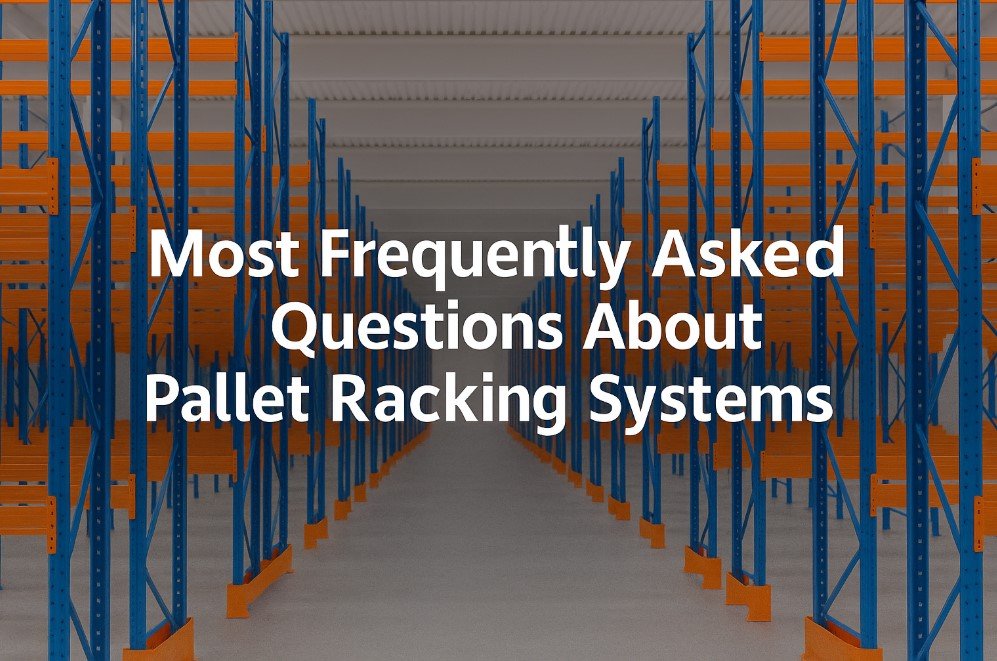Business
Most Frequently Asked Questions About Pallet Racking Systems

Selecting, installing, and maintaining a pallet racking system can seem daunting. To simplify the process, we’ve compiled answers to the most frequently asked questions, addressing system selection, safety, scalability, and compliance considerations.
Common Types of Pallet Racking Systems
Warehouses and industrial facilities have diverse storage requirements. The most prevalent pallet racking configurations include:
- Selective Racking: Grants full access to each pallet. Highly adaptable and ideal for mixed-SKU, high-turnover operations.
- Double-Deep & Drive-In/Through: Stores pallets multiple rows deep. Best for bulk, uniform stock—drive-in follows LIFO, drive-through enables FIFO.
- Push-Back & Gravity Flow (Pallet Flow): Employs inclined carts or rollers for high-density storage. Supports FIFO or LIFO workflows.
- Very Narrow Aisle (VNA): Uses specialized narrow-aisle forklifts. Maximizes space without compromising selectivity.
- Mobile Pallet Racking: Mounted on powered carriages that glide along floor rails. Optimizes capacity with a single movable aisle.
- Cantilever Racking: Perfect for long or irregular loads, such as lumber or piping, with unobstructed frontal access.
- Mezzanine & Multi-Tier Systems: Expand vertically, enhancing storage for carton picking and batch fulfillment.
- Automated Storage & Retrieval Systems (ASRS): Comprising shuttles, vertical lift modules, and cranes—ideal for high-density, high-speed automated operations.
How to Choose the Right System
System selection depends on several factors:
- Nature and variety of products or SKUs
- Inventory turnover (FIFO vs. LIFO requirements)
- Spatial constraints and ceiling height
- Required access: full selectivity or bulk storage
- Budget, labor availability, and scalability needs
For instance, selective racks suit high-SKU-turnover warehouses, whereas drive-in racks excel for uniform bulk storage. Mobile racking systems combine high-density storage with accessibility.
Understanding Rack Capacity
Rack capacity defines the weight each frame or beam can safely bear:
- Beam Capacity: Maximum load between upright frames
- Frame Capacity: Maximum vertical load the structure can sustain
Correctly matching capacity prevents structural failure, product damage, and workplace injuries. Reference rack capacity charts, factoring in pallet weight, beam spacing, and upright height.
Strategies to Maximize Storage Density
Increase storage without expanding the footprint:
- Employ double-deep or pallet-flow systems for compact bulk storage
- Install mobile pallet racking to reduce aisle requirements
- Use VNA racks to enable narrow-aisle, high-density layouts
- Add mezzanines to exploit vertical space for cartons or bulk items
- Organize rack layouts according to SKU velocity—fast-moving items up front, slower-moving items deeper in
Best Practices for Safety
Safety must remain paramount. Essential practices include:
- Select certified, high-quality rack components
- Level and anchor floors precisely
- Install beam locks, column guards, and row spacers
- Train staff on forklift operation and rack protocols
- Conduct regular inspections for dents, corrosion, missing components, or leaning uprights
Routine checks and prompt repairs prevent accidents and prolong system life.
Considering Used Racking Systems
Pre-owned racks offer significant savings while maintaining functionality. Ideal circumstances include:
- Immediate installation needs
- Budget constraints
- Selection of quality components that pass rigorous inspection
Always verify beam depth, load capacity, upright integrity, and compatibility with existing systems.
Customization and Scalability Options
Pallet racks are modular by design. Options include:
- Adjusting beam levels or moving beams for different heights
- Expanding bays or columns for facility growth
- Adding mezzanine platforms
- Upgrading to high-density mobile racking systems
Scalability ensures you invest only in the storage you require—when you require it.
Compliance with Codes and Regulations
Adherence to regulations ensures safety and structural soundness:
- Follow RMI (Rack Manufacturers Institute) design and inspection standards
- Comply with OSHA rules for anchoring, guardrails, and reporting
- Verify seismic rating in applicable regions
- Maintain detailed documentation—engineer drawings, load charts, and inspection records—for audits and liability protection
Reducing Maintenance and Operational Costs
Proactive measures lower expenses and maintain performance:
- Schedule routine inspections and cleaning
- Use protectors to minimize damage
- Train staff rigorously
- Replace damaged beams or frames promptly
- Maintain floors to avoid structural instability
Expected Lifespan of a Racking System
With proper installation and upkeep, racks can last decades. Lifespan is influenced by:
- Forklift impact frequency and severity
- Load management practices
- Environmental conditions, such as humidity or salt exposure
- Material quality and condition at purchase
Regular inspections extend durability and reinforce safety.
Understanding Racking System Costs
Pricing varies by system type and features:
- Selective Racks: Economical and flexible
- VNA and Compact Systems: Higher costs due to precision engineering
- Mobile Racking and ASRS: Premium, reflecting automation and space efficiency
Installation, shipping, and protective accessories should also be factored in.
Reusability and Relocation
High-quality racks can be dismantled and reassembled. Before moving:
- Inspect for wear or damage
- Re-anchor with new floor inserts
- Maintain original layout and beam spacing
- Ensure structural integrity throughout
Recommended Support Services
Professional guidance optimizes efficiency and safety:
- Site analysis and layout consulting
- Structural design and engineering
- Precision installation and anchoring
- Inspection and certification
- Operator and maintenance staff training
Partnering with experts ensures compliance and operational excellence.
Final Thoughts
Selecting the right pallet racking systems is a strategic decision. Understanding system types, capacity limits, and suitability ensures optimal performance. Whether implementing selective racks, compact solutions, or mobile systems, success relies on thoughtful design, stringent safety practices, and diligent maintenance.
When evaluating upgrades, expansions, or safety audits, professional support ensures your warehouse operates at peak efficiency, meets performance standards, and provides lasting peace of mind.
Read more: Things to Keep in Mind when Opting for Pallet Racking for your Business
-

 Social Media2 months ago
Social Media2 months agoWhat the “67” TikTok Meme Really Means
-

 Tech2 months ago
Tech2 months agoWhat To Do When Your Business Faces Network Vulnerabilities
-

 Self Improvement2 months ago
Self Improvement2 months agoUsing BCBS Rehab to Access Quality Addiction Care
-

 Games2 months ago
Games2 months agoPusoy Strategies for Play That Also Work in Pusoy Dos in English






